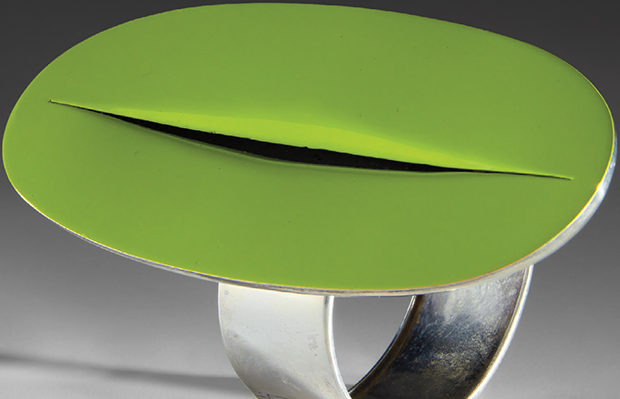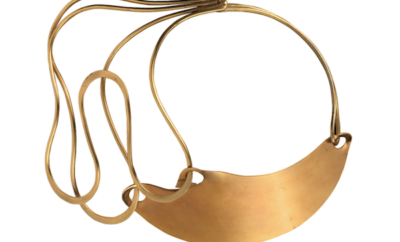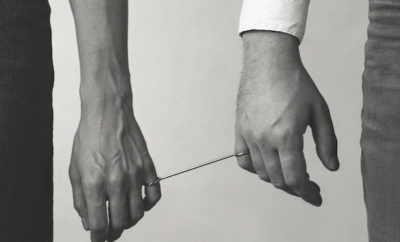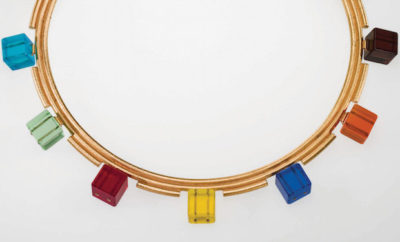
Design
Delving Deeper
Lot 208 Phillips’s Design Evening sale, December 12, 2017: Elisse Concetto Spaziale bracelet, model no. LF/4, designed by Lucio Fontana, produced by GEM, 1968. Estimated at $50,000–$70,000, the piece sold for $137,500. Some reasons for the high price:
ITALIAN/ARGENTINE ARTISTIC EXCHANGE
Lucio Fontana was born in Argentina to Argentine and Italian immigrant parents, and was quickly shuttled back to Italy for his elementary education. He went back and forth between the two countries for decades, starting his artistic practice in Argentina working for his father’s business, which created graveyard statues, and then returning to Italy for more formal education and studio practice. Fontana’s artwork became dedicated to the subtle but deliberate disruption of traditional norms of painting and sculpture. After returning to Argentina in 1940, he introduced the term Concetto Spaziale (Spatial Concept) to describe a group of his drawings, a term that characterized most of his creative thinking and artistic output for the next two decades. In his first spatial concept works, called Buchi (Holes), which appeared in 1949, he contested the dimensionality and very nature of painting by puncturing the surface of his canvases with holes. He said, “Sculpture and painting are both things of the past….We need a new form. Art that’s movement. Art within space.” Following his explorations with holes, Fontana began a series called Tagli (Slashes) in 1958, which have arguably become his most recognizable pieces. Art critic Hilton Kramer described them as “just austere enough to seem meaningful, just violent enough to seem spirited….It is another one of those ‘daring’ ideas that turn into something chic before they can menace a single one of our esthetic assumptions.”

Phillips
FASHION/ART
Later in his life, the ever-experimental Fontana found himself an early collaborator with GEM, the precious metal laboratory established in 1967 by GianCarlo Montebello and his wife Teresa Pomodoro that built a reputation collaborating with contemporary artists on jewelry designs. Fontana created a number of pieces with the studio before his death in 1968, with some designs executed posthumously. The jewelry received high-profile promotion through the photography of Gianfranco Gorgoni and Ugo Mulas, the latter’s images appearing in Vogue. The Fontana bracelet in the Phillips sale—with an oval that stretches nearly wrist to elbow on the wearer—suggests a culmination of Fontana’s later work. It vividly recalls his slash experiments (1958–1968), with its elegant central rupture, hosted within a simple ellipse, echoing his Ellipses series (1964–1967). Fontana’s Spatial Concept morphs meaning when applied to jewelry. While translating well into stylish simplicity, the jewelry intensifies the fetishistic accusations of the slashes, evoking physical harm to the body. His critique of dimensionality is animated by a piece’s interaction with the body, and, in adopting his artwork’s aesthetic to jewelry, Fontana achieved art with motion, art within space.
CASH/CUFF
While Fontana’s artwork sells well at auction, his jewelry has made a limited statement in the market— that’s possibly because fewer than ten pieces are known to have gone up for sale in the past decade, according to Cordelia Lembo, specialist and Head of Sale in Design at Phillips. But this piece may start a new trend. “This was a very exciting lot,” Lembo reports. “The auctioneer opened bidding at $38,000 and it really came down to two determined phone bidders. Bidding lasted over three and a half minutes, which is quite a long time in the auction world.” Wrestling up to a final price nearly double the high end of the estimate, the piece was clasped by an American private collector. Sold with a promotional photograph by Gianfranco Gorgoni depicting a bare-shouldered model defiantly wielding the bracelet diagonally across the picture plane, the ensemble encapsulates the chic radicalism of Italian modernism and the lifestyle it espoused. Lembo attributes the sale’s success to the rarity of such pieces in the market, as well as to increasing cross-category interest among collectors. “This bracelet is a wonderful example of a work that transcends barriers,” she observes, “appealing to collectors who have traditionally collected primarily design, contemporary art, or jewelry.”












